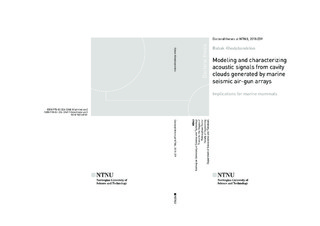| dc.contributor.advisor | Landrø, Martin | |
| dc.contributor.advisor | Johansen, Ståle Emil | |
| dc.contributor.author | Khodabandeloo, Babak | |
| dc.date.accessioned | 2018-09-25T11:53:53Z | |
| dc.date.available | 2018-09-25T11:53:53Z | |
| dc.date.issued | 2018 | |
| dc.identifier.isbn | 978-82-326-3269-5 | |
| dc.identifier.issn | 1503-8181 | |
| dc.identifier.uri | http://hdl.handle.net/11250/2564378 | |
| dc.description.abstract | Marine seismic air-gun arrays generate not only low-frequency (<∼300 Hz) acoustic waves which benefit seismic imaging, but also high-frequencies up to tens of kilohertz. Although such high-frequencies are much weaker than the lowfrequency parts, they might impact cetacean species that are sensitive to acoustic signals in the high-frequency range (10−150 kHz). Ghost cavitation is believed to be the main underlying mechanism for such high-frequency (>10 kHz) acoustic signals.
In this doctoral thesis, ghost cavitation phenomenon is studied through numerical modeling and field measurements. Ghost cavity cloud consists of several acoustically induced cavities which are formed due to the pressure drop caused by reflected pressure waves, i.e. ghost, from the sea surface.
The thesis is a collection of several independent papers organized in chapters together with an introductory part (chapter 1) which reviews the key concepts that are relevant as background and motivation for the work presented.
In chapter 2, A synthetic modeling scheme for simulation of acoustically induced cavitation in seismic air-gun arrays is developed. The growth and subsequent collapse of individual cavities around the array are modeled by bubble dynamic equations.
The pressure fields generated by individual cavities are added to model the acoustic signal form the cavity cloud. To validate the modeling technique, the simulation results are compared to the field recorded data.
In chapter 3, using the numerical modeling scheme, high-frequency emissions caused by ghost cavitation for two different air-gun arrays are compared. The developed numerical scheme has the potential to evaluate air-gun arrays regarding the amount of high-frequency ghost cavitation acoustic signal.
In chapter 4, photographed ghost cavity cloud by a high-speed video camera in a field experiment are presented which provide an undebatable evidence of the phenomenon. Furthermore, the modeling scheme for the cavity cloud is further evaluated.
In chapter 5, sound velocity within the cavity cloud was investigated using a kspace pseudo-spectral numerical method. Presence of several small vapor cavities has potential to significantly drop the sound speed of water within the cavity cloud at frequencies below the resonance frequencies of the cavities. It is shown that if the sound velocity drops within the cavity cloud, though for a short time (8-10ms), it affects the far-field acoustic pressure.
In the appendix, the effects of cavity collapses within the ghost cavity cloud on the near-field hydrophones are simulated. In this paper, the model is tuned (calibrated) such that both the amplitude of the high-frequency modeled signal and its associated low-frequency part match the measurements. | nb_NO |
| dc.language.iso | eng | nb_NO |
| dc.publisher | NTNU | nb_NO |
| dc.relation.ispartofseries | Doctoral theses at NTNU;2018:239 | |
| dc.relation.haspart | Khodabandeloo, Babak; Landrø, Martin; Hanssen, Alfred. Acoustic generation of underwater cavities - Comparing modeled and measured acoustic signals generated by seismic air gun arrays. Journal of the Acoustical Society of America 2017 ;Volum 141.(4) s. 2661-2672
https://doi.org/10.1121/1.4979939
All article content, except where otherwise noted, is licensed under a Creative Commons Attribution (CC BY) license | nb_NO |
| dc.relation.haspart | Khodabandeloo, Babak; Landrø, Martin. High frequency ghost cavitation - a comparison of two seismic air-gun arrays using numerical modeling. Energy Procedia 2017 ;Volum 125. s. 153-160
https://doi.org/10.1016/j.egypro.2017.08.158
Attribution-NonCommercial-NoDerivatives 4.0 International (CC BY-NC-ND 4.0) | nb_NO |
| dc.relation.haspart | Khodabandeloo, Babak; Landrø, Martin. Acoustically induced cavity cloud generated by air-gun arrays—Comparing video recordings and acoustic data to modeling. Journal of the Acoustical Society of America 2018 ;Volum 143.(6) s. 3383-3393
https://doi.org/10.1121/1.5040490
Copyright 2018 Acoustical Society of America. This article may be downloaded for personal use only. Any other use requires prior permission of the author and the Acoustical Society of America. | nb_NO |
| dc.relation.haspart | Characterizing acoustic properties of cavity cloud as a time-dependent effective medium surrounding an air-gun array | nb_NO |
| dc.relation.haspart | Khodabandeloo, Babak; Landrø, Martin. Effects of ghost cavitation cloud on near-field hydrophone measurements in the seismic air gun arrays. 79th EAGE Conference and Exhibition 2017
https//doi.org/10.3997/2214-4609.201700845 | nb_NO |
| dc.title | Modeling and characterizing acoustic signals from cavity clouds generated by marine seismic air-gun arrays: Implications for marine mammals | nb_NO |
| dc.type | Doctoral thesis | nb_NO |
| dc.subject.nsi | VDP::Technology: 500::Rock and petroleum disciplines: 510::Petroleum engineering: 512 | nb_NO |
